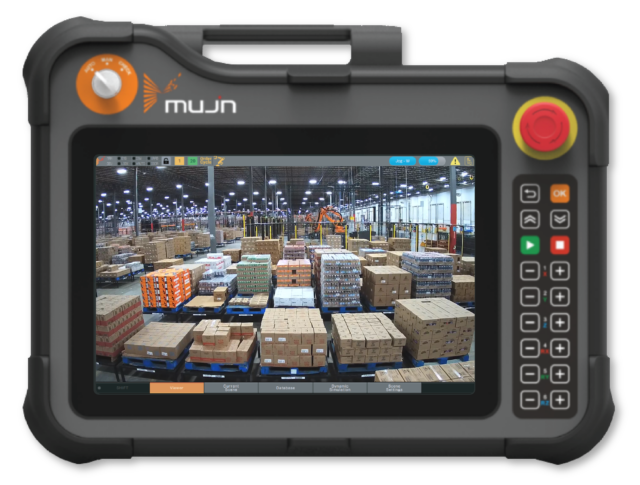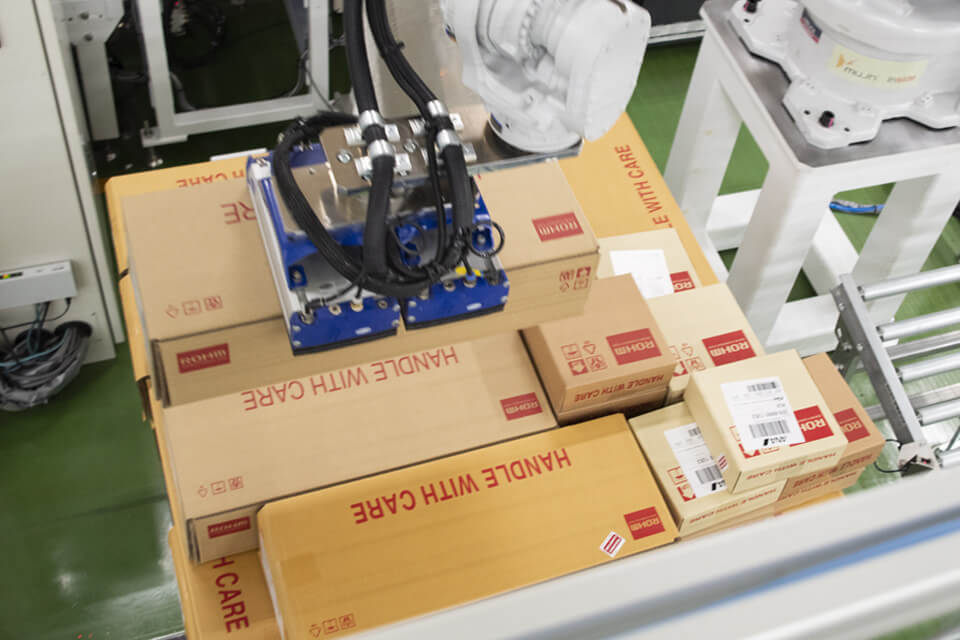Manufacturers today face increasing pressure to do more with less — fewer workers, shorter production runs, tighter packaging requirements, and nonstop SKU churn. Amid that complexity, one task remains central to how products leave the factory: palletizing.
But while palletizing has long been a candidate for automation, adoption remains surprisingly low. As of 2025, only 29% of warehouses worldwide had implemented any form of automation, and fewer still had automated palletizing in place. For many facilities, this final stage of production remains a manual, labor-intensive bottleneck.
That’s changing. A new generation of intelligent, no-code palletizing systems — led by solutions like MujinOS — is transforming end-of-line operations. These systems combine industrial reliability with fast deployment, dynamic adaptability, and a level of ease that empowers operators without programming expertise.
For manufacturers running high-throughput lines or managing high SKU volume, the business case is clear: intelligent palletizing isn’t just automation — it’s a strategic advantage.
Robotics in Manufacturing: Promise and Reality
Robotics is no longer a futuristic concept; it is reshaping how products move through manufacturing and logistics every day. From palletizing and depalletizing to complex material handling, robots promise higher throughput, improved safety, and reduced reliance on manual labor. Yet as manufacturers adopt automation, many quickly discover that the journey is more complicated than expected. Robotics offers transformative potential but realizing it requires navigating real challenges that go beyond simply purchasing machines.
The Problems Manufacturers Face
One of the most immediate barriers to robotics adoption is the high upfront cost. Robots require substantial investment in hardware, integration, and training. For smaller operations, or those managing large numbers of SKUs, the return on investment is not always immediate, making it difficult to justify.
Even when investment hurdles are overcome, manufacturers encounter the complexity of integration. Most facilities do not operate in a greenfield environment; they rely on legacy equipment, conveyors, and software systems that were never designed with robotics in mind. Achieving seamless coordination between robots, AMRs, AGVs, and warehouse execution systems can be an engineering challenge.
Workforce dynamics present another obstacle. Labor shortages remain a pressing issue, but so does the skills gap within the workforce that remains. Robotics has historically required specialized programming and ongoing maintenance, capabilities that many manufacturers do not possess in-house.
Flexibility itself is a critical gap for traditional robotics. Robots excel at predictable, repetitive tasks, but real-world operations are full of variability. Packaging sizes, stacking patterns, and product orientation often change day to day, especially in industries managing SKU proliferation. A large retailer’s e-commerce warehouse tested a traditional robotic system for multi-SKU palletizing, only to find it stalled whenever package shapes or orientations deviated from the original programming. Instead of efficiency, the pilot created bottlenecks.
Downtime further complicates the picture. Breakdowns, calibration issues, and the scarcity of replacement parts can bring entire production lines to a standstill.
Safety and compliance add another layer of complexity. Integrating robots alongside human workers requires strict adherence to standards without sacrificing efficiency.
Finally, the data generated by robots is both a challenge and an opportunity. Robots produce vast streams of information, but without the infrastructure to collect, analyze, and secure it, most of that data remains underutilized. A global supply chain operator shared that they had robots across multiple sites, but no unified system for data capture—making it impossible to optimize performance consistently across facilities.
How Mujin Solves These Challenges
Mujin was founded with a clear vision: to remove the barriers that have historically slowed robotics adoption. At the heart of this approach is MujinOS, a vendor-agnostic control platform that redefines how robots are deployed and managed. By eliminating the need for teaching and programming through parameterized task logic, Mujin reduces both the upfront costs and the time it takes to see a return on investment. Robots can adapt instantly to changes in product mix, enabling manufacturers to achieve flexibility without sacrificing reliability.
A 3PL client saw deployment times shrink by nearly 40% because Mujin’s zero-teaching system allowed operators to get robots palletizing in hours, not weeks. For them, automation was no longer a long-term gamble—it was an immediate performance boost.
Integration is simplified by design. MujinOS works with any robotic hardware vendor and leading PLC and sensor brands, which means manufacturers are not locked into a single vendor or forced to overhaul their existing infrastructure. A global CPG company leveraged this flexibility to scale robotics across three facilities with entirely different conveyor and WMS setups—something that would have been impossible with a single-vendor solution.
Equally important is addressing the workforce challenge. Mujin’s platform allows operators to manage automation without needing to become robot programmers. Tasks are planned and executed autonomously, giving staff the freedom to focus on higher-value activities.
Flexibility is where Mujin’s approach stands apart. By combining advanced motion planning with real-time 2D and 3D vision, Mujin-powered robots can handle the messy realities of modern manufacturing. Whether it is single SKU, multi-SKU palletizing or depalletizing, the system adapts to packaging variations, product orientations, and pallet configurations.
Reliability is reinforced through Mujin’s use of a live digital twin, which validates every robot motion before execution. This prevents costly errors and minimizes downtime. Predictive diagnostics further strengthen operational resilience, identifying potential issues before they disrupt production.
Finally, Mujin transforms data from a burden into a resource. Through a unified orchestration layer, data flows seamlessly between robots, AMRs, and work zones, offering real-time visibility and actionable insights. A global CPG company now monitors performance across multiple countries from a single dashboard, turning fragmented data into proactive decision-making power.
The challenges facing manufacturers in robotics adoption—cost, integration, labor, flexibility, downtime, safety, and data—are significant. Yet they do not have to be roadblocks. By tackling these issues directly, Mujin has redefined what robotics can deliver. The company’s platform accelerates ROI, reduces reliance on specialized labor, integrates seamlessly with existing systems, and makes robots flexible enough to handle the unpredictability of real-world operations.
The future of robotics is not simply about replacing human labor or driving efficiency. It is about building resilience in supply chains, empowering workforces, and enabling manufacturers to scale sustainably in an increasingly complex global landscape. With Mujin, that future is not theoretical—it is already being realized on factory floors around the world.


